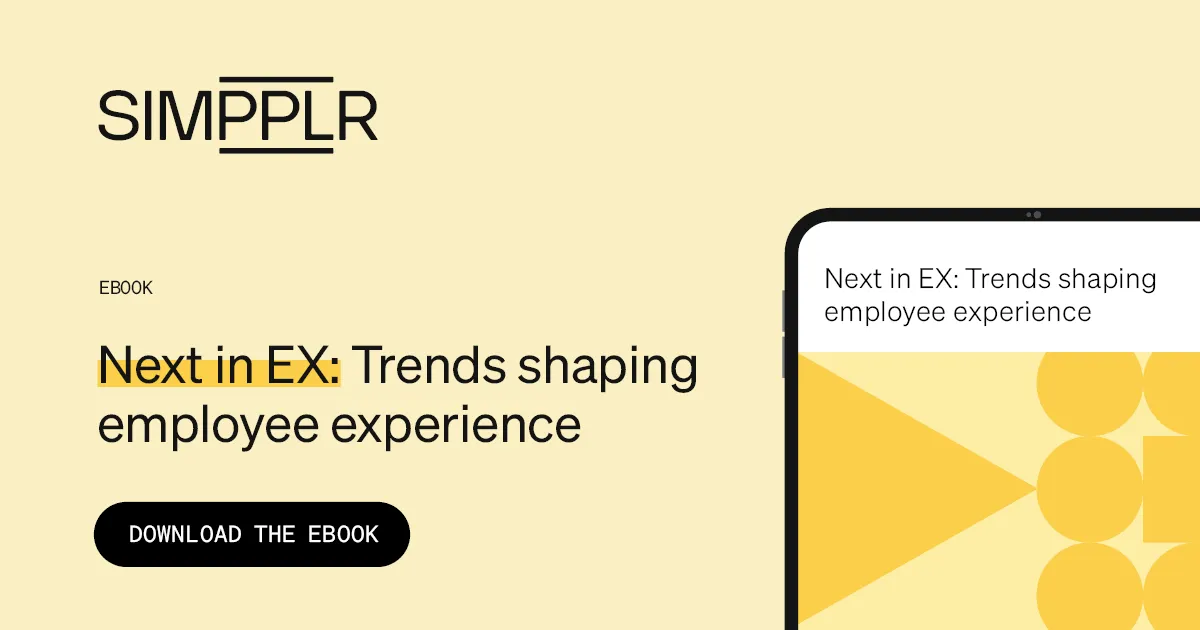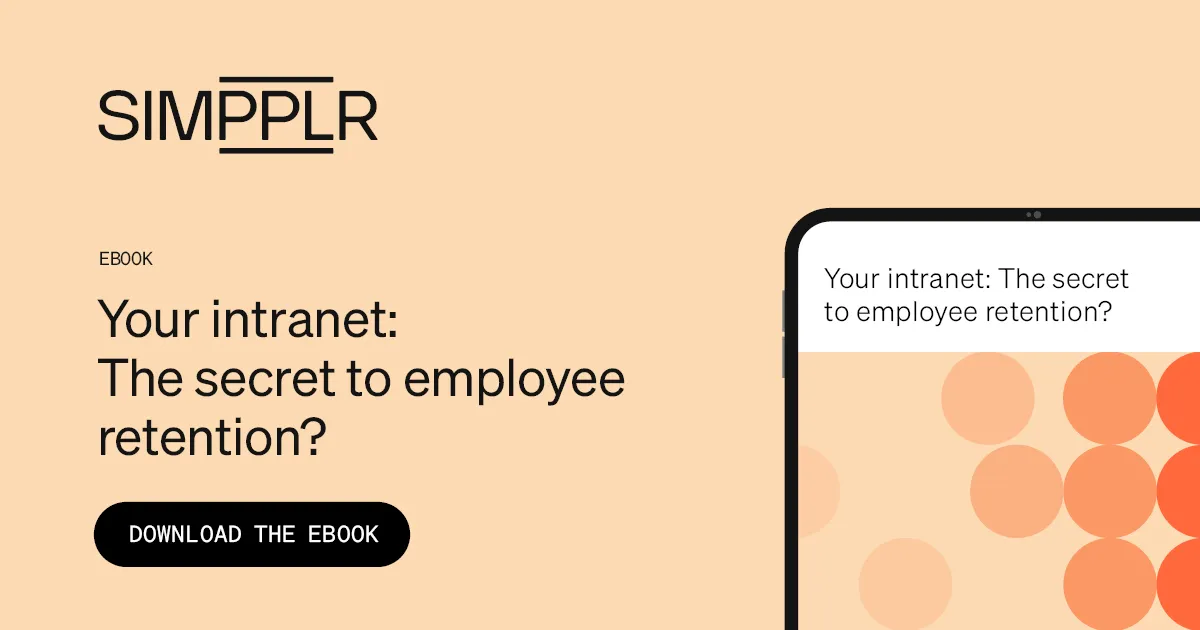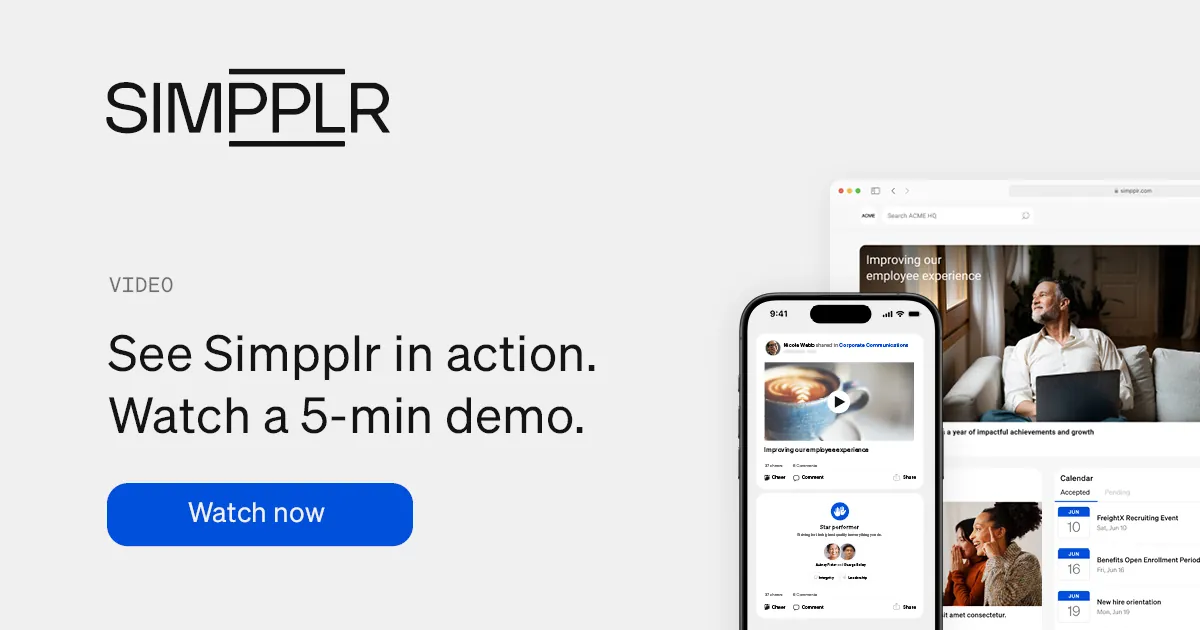When your people feel supported and valued, they’re more likely to stick around, boosting retention rates. That’s where employee development plans can make a difference.
It’s a no-brainer that your people want more than just a paycheck. A whopping 94% of employees would stay with a company longer if it invested in their learning and development. And more than one-third believe that this investment is one of the most important workplace benefits.
Prioritizing employee development and providing avenues for continuous learning show your people that you care about helping them grow and be more successful now and down the road.
How to create successful employee development plans
This article explores everything you need to know about employee development plans — what they are, why they matter, and how to create them effectively. Plus, we’ll provide examples and a template to guide you every step of the way.
Let’s dive in!

What is an employee development plan?
An employee development plan is a structured strategy designed to enhance an employee’s skills, knowledge and abilities to achieve career goals and contribute effectively to the organization. It outlines specific actions and resources needed to support the employee’s professional growth.
These plans are crafted through collaboration between the employee and their manager, taking into account the employee’s current competencies, career aspirations and areas for development. Planning and implementing an effective development plan essentially involves:
- Identifying the skills people want and the organization needs
- Setting up or sourcing expert-led courses and workshops for skill development
- Creating clear goals and methods to track progress
- Using templates tailored for individual employees with space for ongoing updates
Key benefits of employee development
Wondering whether it’s really worth the effort to create employee development plans? It is, and here’s why:
- Improved performance: Employee development equips your workforce with the skills and knowledge necessary to excel in their roles, increasing productivity and efficiency.
- Enhanced employee engagement: Your people will feel more motivated and loyal if you show that you are committed to their professional development, which in turn increases engagement and job satisfaction.
- Talent retention: Offering chances for professional growth lets your people know that you appreciate what they do and want to help them grow into new skills or areas that interest them. This lowers turnover rates and expenses related to hiring and onboarding new employees.
- Increased innovation: Empowered employees are more likely to think creatively and contribute new ideas, driving innovation and market competitiveness.
- Succession planning: Developing a pipeline of skilled and capable employees ensures a smooth transition of key roles within the organization, mitigating risks associated with leadership gaps or unexpected departures.
- Enhanced employer brand: A reputation for investing in employee development attracts top talent, positioning you as an employer of choice within your industry.
Types of employee growth plans
Employee development plans come in different forms to address specific employee and organizational needs and objectives. It’s important to align plans with both your peoples’ aspirations and the organization’s goals. Here are three main types of employee growth plans to consider:
1. Development within the current role
How can your people excel in their existing roles? This type of plan focuses on enhancing the skills and competencies needed to perform current job functions more effectively.
- Key areas: Improving technical skills, enhancing soft skills like communication and teamwork, and mastering job-specific tools and processes.
- Benefits: Boosts job performance, increases job satisfaction and builds confidence in existing roles.
2. Development for career progression
What steps should your people take to advance their careers? This plan prepares employees for higher responsibilities and leadership positions within the organization.
- Key areas: Leadership training, project management, advanced certifications, and mentoring programs.
- Benefits: Prepares employees for promotions, strengthens the leadership pipeline, and supports succession planning.
3. Development for a new career track
How can your people transition to a different career path within the organization? This type of plan helps employees acquire new skills and knowledge to switch to a different role or department.
- Key areas: Cross-training, attending industry-specific workshops, gaining new qualifications, and job shadowing.
- Benefits: Promotes internal mobility, aligns employee interests with organizational needs, and reduces turnover by offering new career opportunities.
5 steps to craft an effective employee development plan
To create an effective development plan, strategically align your peoples’ individual growth goals with the organization’s needs and objectives. Here’s how.
Step 1: Assess individual needs
Find out about each team member’s unique requirements and goals by conducting personalized assessments to gain insights into their ambitions and current skill sets, strengths and areas for improvement.
People want to feel heard, so involve them in the process. Actively listen to their career aspirations and learning objectives to ensure that the growth plan addresses their personal objectives. Here are some important things to keep in mind:
- Initiate one-on-one conversations to understand employees’ long-term career aspirations and short-term development objectives.
- Analyze past performance evaluations and supervisor feedback to identify recurring themes and areas for growth.
- Incorporate various assessment tools or surveys to gather quantitative data on employees’ proficiency levels and pinpoint specific skill-enhancing areas.
Step 2: Define clear objectives
With a solid understanding of each employee’s needs, define clear and achievable objectives for their development journey that align with both their career aspirations and the organization’s strategic goals.
Start by outlining specific areas for improvement or skill enhancement based on the assessment conducted in the previous step. Clearly articulate the desired outcomes and milestones your people should aim for to achieve within a specified timeframe. As you define clear objectives, remember to:
- Align individual development objectives with the organization’s goals to ensure synergy and relevance.
- Break down larger goals into smaller, actionable steps that are measurable and achievable.
- Clearly communicate expectations and timelines to your people, empowering them to take ownership of their development journey.
Step 3: Engage SMEs and leadership champions
Next, assemble a team of experts and managers to support and guide employees in their development journey. Identify individuals with the necessary expertise and experience to mentor and coach employees in their growth areas. And involved managers to provide valuable feedback and guidance, ensuring alignment with organizational priorities.
As you navigate this phase, keep these points in mind:
- Find the right internal subject matter experts to provide specialized training or mentorship to employees. Make sure they can commit to the time and effort needed to be successful.
- Engage managers who can offer insights and feedback on employees’ progress and development needs.
- Collaborate with external partners or consultants if additional expertise or resources are required.
Step 4: Develop a plan
With objectives set and support structures in place, it’s time to develop a comprehensive plan outlining the actions and resources needed to facilitate employee development. Design a tailored roadmap that includes formal training programs, on-the-job learning opportunities, mentorship, and coaching sessions.
Make the plan flexible enough to accommodate individual learning styles and preferences while remaining aligned with organizational priorities.
Be sure to:
- Design a structured development plan incorporating various learning modalities to cater to diverse learning needs.
- Set realistic deadlines and milestones to track progress and measure success.
- Assign clear responsibilities and roles to stakeholders involved in implementing the development plan.
Step 5: Evaluate and adjust
Employee development plans are living documents. Regularly monitor your peoples’ progress toward their objectives, solicit feedback from colleagues and managers, and make necessary adjustments to the plan.
Stay agile and responsive to changing circumstances, emerging priorities, and evolving skill requirements to maximize the impact of the development initiatives.
In the ongoing evaluation process, remember to:
- Implement regular check-ins and progress reviews to assess employees’ development journey.
- Solicit feedback from colleagues and managers to identify areas of improvement and make necessary adjustments.
- Remain flexible and adapt the development plan to address changing organizational needs and individual growth trajectories.
Back to top

Employee development plan examples to empower your team’s growth
Check out a few examples of different employee development plans to guide you in creating plans that cater to various objectives and scenarios:
Time-frame-based employee development plan
One practical approach to setting up an employee development plan is to base it on a specific time frame. This means laying out a roadmap for skill enhancement or goal achievement within a set period — an approach that benefits people who thrive on clear deadlines and structured progress tracking.
By setting a time frame, employees clearly understand the expectations and deadlines for their development. This keeps them focused and motivated to achieve their goals within the designated period. It also allows managers to monitor progress more effectively and provide timely support or adjustments.
Example: Six-month development plan for a junior developer
Objective: Enhance coding skills and gain proficiency in a new programming language.
Development activities:
- Complete an online course in Python within three months.
- Participate in weekly coding challenges to apply new skills.
- Attend monthly tech meetups or webinars to stay updated on industry trends.
Evaluation:
- Monthly progress check-ins with the team lead.
- Review completed coding challenges for accuracy and efficiency.
- Final assessment based on a project developed using Python.
Skill-based employee development plan
Another practical approach to developing your people is enhancing specific skills crucial for an employee’s role or career growth. This skill-based approach allows people to pinpoint areas for improvement and take targeted actions to strengthen their capabilities.
Focusing on specific skills allows people to make tangible progress and see direct improvements in their performance. This approach also allows for a more personalized development experience tailored to the individual’s needs and career aspirations.
Example: Skill enhancement for a customer service representative
Objective: Improve communication and problem-solving skills to handle complex customer issues.
Development activities:
- Attend a three-day workshop on advanced customer service techniques.
- Role-play different customer scenarios weekly to practice new skills.
- Receive biweekly coaching sessions from a senior representative.
Evaluation:
- Monitor improvements in customer satisfaction scores.
- Weekly feedback sessions to assess role-play performance.
- Quarterly performance reviews focusing on communication and problem-solving abilities.
Objective-based employee development plan
An objective-based employee development plan involves setting specific, measurable objectives that contribute to personal and organizational goals. This approach provides clarity and focus, enabling your people to track their progress and gauge their success.
Define clear goals for people to follow, and they will know precisely what is expected of them — ensuring alignment between individual development and organizational priorities, and nurturing greater productivity and effectiveness.
Example: Career advancement for a marketing coordinator
Objective: Prepare for a promotion to Marketing Manager.
Development activities:
- Enroll in a leadership training program focused on strategic marketing.
- Manage a small team on a pilot campaign project.
- Shadow the current marketing manager for two days each month.
Evaluation:
- Track leadership skills and project outcomes in quarterly reviews.
- Collect feedback from team members and the marketing manager.
- Assess completion of the leadership program and application of strategic insights.
Performance-based employee development plan
In a performance-based employee development plan, the focus is on improving overall job performance by setting specific targets related to key performance indicators (KPIs) and implementing strategies to enhance productivity and effectiveness.
Aligning development goals with performance metrics enables your people to directly impact their contribution to the organization. This approach also provides a clear framework for assessing progress and identifying areas for improvement.
Example: Performance improvement for a sales associate
Objective: Increase sales conversion rates and improve client relationship management.
Development activities:
- Attend a sales training seminar on advanced closing techniques.
- Implement a new CRM tool to streamline client interactions.
- Receive weekly mentoring sessions from a top-performing sales colleague.
Evaluation:
- Monitor changes in sales conversion rates monthly.
- Review CRM tool usage and its impact on client management.
- Biweekly performance check-ins with the sales manager.
Company growth-focused employee development plan
A company growth-focused employee development plan aligns individual development efforts with the organization’s strategic growth objectives to ensure that employee growth contributes directly to the company’s overall success and expansion.
When personal growth objectives are connected to business expansion plans, employees have a sense of purpose and alignment with the company’s objectives.
This strategy also promotes innovation and a culture of constant development.
Example: Preparing a financial analyst for organizational expansion
Objective: Equip the analyst with skills to support company growth and scalability.
Development activities:
- Take advanced courses in financial modeling and forecasting.
- Lead a cross-departmental project on budget optimization.
- Participate in strategic planning meetings with senior management.
Evaluation:
- Quarterly assessments of financial models and forecast accuracy.
- Feedback from cross-departmental project participants.
- Performance review based on contributions to strategic planning initiatives.
Side-by-side employee development plan
In a side-by-side development plan, employees work closely with a mentor or peer to enhance their skills and knowledge. This collaborative approach facilitates learning through observation, feedback and hands-on experience.
Working with a mentor or peer provides employees with real-world examples and practical insights invaluable for their development.
This method also promotes information exchange and a positive learning atmosphere.
Example: Paired development for two team members
Objective: Create collaboration and mutual skill enhancement between a designer and a developer.
Development activities:
- Work together on a joint project to redesign the company website.
- Participate in weekly knowledge-sharing sessions to teach each other design and coding basics.
- Attend a UX/UI workshop together to integrate design and development perspectives.
Evaluation:
- Assess project outcomes based on user feedback and website performance metrics.
- Monitor progress in knowledge-sharing sessions.
- Collect feedback from both team members on their collaborative experience.
Individual-based employee development plan
An individual employee development plan focuses on unique career goals and aspirations. This approach cultivates a sense of ownership and motivation by tailoring development efforts to peoples’ specific needs and interests.
At the heart of personalized growth and continuous learning, individualized development plans promote a culture of self-improvement and adaptability.
When professional goals are acknowledged and encouraged, people feel appreciated and are more inclined to make personal investments in their own growth.
Example: Personalized plan for a data analyst
Objective: Expand expertise in data visualization and storytelling
Development activities:
- Enroll in a data visualization certification course.
- Create monthly data reports with visual insights for different departments.
- Attend a conference on data analytics and visualization.
Evaluation:
- Review course completion and certification.
- Collect feedback from departments on the usefulness of data reports.
- Assess knowledge gained and applied from conference attendance.
Staff development plan
Staff development initiatives involve organization-wide plans to enhance all your peoples’ capabilities and skills. These initiatives ensure the workforce has the necessary knowledge and competencies to drive organizational success.
Investing in staff development promotes a culture of ongoing learning — driving employee retention, productivity and engagement.
Example: Company-wide development program
Objective: Promote continuous learning and professional growth across the organization
Development activities:
- Implement a quarterly training program with diverse topics such as leadership, technical skills and wellness
- Establish a mentorship program pairing new employees with experienced staff
- Offer tuition reimbursement for job-related courses and certifications
Evaluation:
- Track participation rates and feedback from training sessions.
- Monitor the effectiveness of the mentorship program through mentee progress.
- Evaluate the impact of external courses and certifications on job performance.
Professional development plan
Employee professional development plans focus on advancing peoples’ careers through skill enhancement, training and career growth opportunities. These plans help your people achieve their career aspirations while benefiting the organization through increased expertise and job satisfaction.
Professional development plans demonstrate an organization’s commitment to supporting employees’ career growth and progression — an investment that attracts and retains top talent.
Example: Growth plan for an HR specialist
Objective: Develop expertise in employee engagement and retention strategies
Development activities:
- Attend workshops and seminars on employee engagement best practices.
- Lead an initiative to improve the company’s employee recognition program.
- Conduct regular surveys and focus groups to gather employee feedback.
Evaluation:
- Assess the implementation and impact of the new recognition program.
- Review survey and focus group results for improvements in engagement.
- Quarterly performance reviews focusing on newly acquired skills and initiatives led.

Putting it all together
Whether you’re focused on skill-based training, cross-departmental development, or professional growth initiatives, the key is to align your development efforts with both individual aspirations and organizational objectives.
Integrating employee development into the intranet makes accessing training resources, joining mentorship programs, and tracking progress easier. A modern intranet can also provide valuable insights into employee engagement and experience, enabling HR teams to tailor development programs accordingly.
Ready to see how Simpplr’s AI-powered Intranet can supercharge your workplace and take your people to the next level? Watch a quick demo to see Simpplr in action.


















